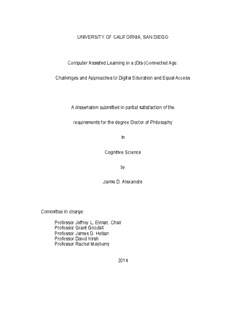
(Dis-)Connected Age - Jamie Alexandre PDF
Preview (Dis-)Connected Age - Jamie Alexandre
UNIVERSITY OF CALIFORNIA, SAN DIEGO Computer Assisted Learning in a (Dis-)Connected Age: Challenges and Approaches to Digital Education and Equal Access A dissertation submitted in partial satisfaction of the requirements for the degree Doctor of Philosophy in Cognitive Science by Jamie D. Alexandre Committee in charge: Professor Jeffrey L. Elman, Chair Professor Grant Goodall Professor James D. Hollan Professor David Kirsh Professor Rachel Mayberry 2014 UMI Number: 3615303 All rights reserved INFORMATION TO ALL USERS The quality of this reproduction is dependent upon the quality of the copy submitted. In the unlikely event that the author did not send a complete manuscript and there are missing pages, these will be noted. Also, if material had to be removed, a note will indicate the deletion. UMI 3615303 Published by ProQuest LLC (2014). Copyright in the Dissertation held by the Author. Microform Edition © ProQuest LLC. All rights reserved. This work is protected against unauthorized copying under Title 17, United States Code ProQuest LLC. 789 East Eisenhower Parkway P.O. Box 1346 Ann Arbor, MI 48106 - 1346 Signature page The Dissertation of Jamie D. Alexandre is approved, and it is acceptable in quality and form for publication on microfilm and electronically: ________________________________________________________________ ________________________________________________________________ ________________________________________________________________ ________________________________________________________________ ________________________________________________________________ Chair University of California, San Diego 2014 iii Dedication For Isabelle You found me in the darkness And gave me the courage To step into the light of day To live the life I wanted to live With you there by my side Every step of the way iv Table of Contents Signature page.......................................................................................................iii Dedication...............................................................................................................iv Table of Contents....................................................................................................v List of Figures.........................................................................................................ix Acknowledgments................................................................................................xiv Vita........................................................................................................................xxi Abstract of the Dissertation.................................................................................xxii Chapter 1: Introduction and overview.....................................................................1 What is the purpose of education?.....................................................................1 A brief history of educational inclusion...............................................................2 Global barriers to equal educational access......................................................5 Overview of the questions and challenges addressed in this dissertation.........6 Chapter 2: Tutoring, Computer Assisted Language Learning, and ESL Genie......9 Introduction.........................................................................................................9 Human and computer tutoring..........................................................................10 The power of a tutor.....................................................................................10 Equality of access to tutoring........................................................................11 Automated tutoring.......................................................................................12 Computer Assisted Language Learning...........................................................13 Order of acquisition effects...........................................................................13 Order effects and pedagogy.........................................................................15 Approaches to CALL....................................................................................16 v Item Response Theory and methods for adaptive testing................................18 Overview.......................................................................................................18 Structured knowledge domain......................................................................20 Inference in a Bayesian IRT system.............................................................22 ESL Genie: An investigation into adaptive error diagnosis in ESL learners.....26 Introduction...................................................................................................26 Quiz interface design....................................................................................30 Methods........................................................................................................34 Exclusion criteria..........................................................................................40 Demographics..............................................................................................41 Analysis........................................................................................................42 Results from Item Response Theory testing................................................45 Exploring information sources for estimating prior ability............................54 Results from the self-paced reading task.....................................................58 ESL Genie conclusion......................................................................................64 Chapter 3: Online education and the digital divide...............................................66 Open Educational Resources...........................................................................66 You say you want a revolution: Khan Academy, and the MOOCs...................67 The online learning revolution......................................................................67 Pedagogical explorations: self-paced learning and flipping the classroom.68 The digital divide...............................................................................................69 The historical divide......................................................................................69 The days of proto-Internet............................................................................70 vi The emergence of the Internet.....................................................................72 Access to the Internet.......................................................................................73 Where is the “cloud”?...................................................................................75 Acknowledging the digital divide..................................................................78 Chapter 4: Taking the online learning revolution offline with KA Lite....................81 Identifying opportunities and approaches.........................................................81 The rise of low-cost computing.........................................................................82 The parallel revolution..................................................................................82 One Laptop Per Child...................................................................................83 Android and the Aakash...............................................................................84 The Raspberry Pi.........................................................................................87 Design considerations for KA Lite.....................................................................88 Be able to install and work offline.................................................................88 Basic features like video watching and exercise interaction........................89 Progress tracking, points, and coach reports...............................................90 Support content updates..............................................................................91 Data synchronization (eventual consistency)...............................................91 Cross-platform support (portability)..............................................................93 Running on low-powered and inexpensive hardware..................................94 Ease of installation process..........................................................................95 Internationalization.......................................................................................95 KA Lite deployment contexts............................................................................96 Classrooms: Burmese monastery school.....................................................96 vii Classrooms: Nalanda Project.......................................................................97 Orphanage..................................................................................................101 Correctional facilities..................................................................................102 Empowering local community-driven content creation...................................107 Education and culture.................................................................................107 Linguistic diversity of Open Educational Resources..................................109 Looking forwards........................................................................................110 Chapter 5: Whither now?....................................................................................112 ESL Genie.......................................................................................................112 KA Lite.............................................................................................................114 Appendices..........................................................................................................117 Appendix A: Tagging scheme for annotating errors in essays........................117 Appendix B: 84 known countries where KA Lite has been installed...............118 Appendix C: Linguistic diversity and language proportions in Open Educational Resource repositories.....................................................................................119 References..........................................................................................................121 viii List of Figures Figure 1: Examples of successful and failed parses in a unification grammar....17 Figure 2: Example 3PL (3 parameter logistic) sigmoidal item response function 19 Figure 3: Hypothetical graph structure used to predict response measures........21 Figure 4: Distributions and links between latent proficiency and response measures..............................................................................................................22 Figure 5: Effect on the posterior proficiency estimate of answering questions with varying difficulty either correctly or incorrectly......................................................25 Figure 6: Effect on mean estimated proficiency of question difficulty and discrimination (cooler colors mean a lower-variance, i.e. more confident, posterior)...............................................................................................................26 Figure 7: Estimated distribution of first languages in the AWPE essay corpus....28 Figure 8: AWPE transcription interface with magnifying glass.............................29 Figure 9: Distribution of error tags in the transcribed essay corpus from ESL and non-ESL writers.....................................................................................................30 Figure 10: Versions of color-coding correctness on questions, before user testing (top) and after user testing (bottom).....................................................................33 Figure 11: Inline “fill in the blank” question display on hover................................34 Figure 12: Subject flow through the stages of the experiment.............................35 Figure 13: English background information on the profile page...........................36 Figure 14: Language autocompletion tool to gather detailed information about languages spoken.................................................................................................37 Figure 15: Language proportion interface............................................................38 ix
Description: